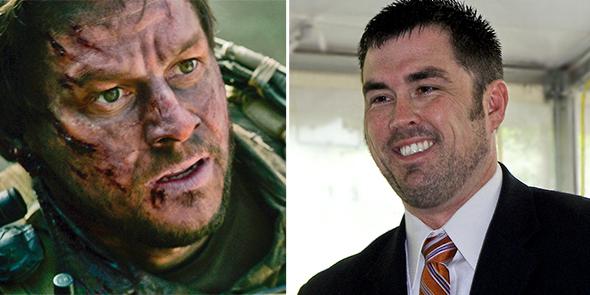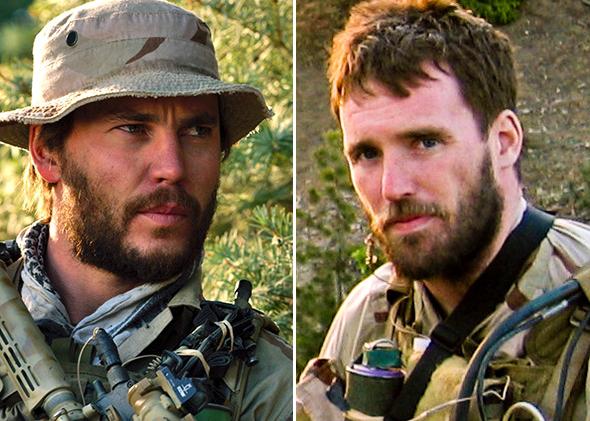Much has been made of the accuracy of Lone Survivor, which has been widely praised for its realism and even named “one of the most realistic war movies of all time.” To provide much of its authenticity, writer-director Peter Berg worked closely with Marcus Luttrell, the Navy SEAL played by Mark Wahlberg in the film, and the author of the memoir of the same name. However, while the movie recreates many of the realities of war in painstaking detail, it also diverges significantly from the real-life Operation Red Wings.
In an article on OnViolence.com, Michael and Eric Cummings detail many of the creative liberties the movie takes with its portrayal of the mission. For example, Luttrell didn’t flatline, Shah probably wasn’t a member of al Qaeda, and the final battle depicted in the film never happened. The article has been adapted and reprinted with their permission below.
Marcus Luttrell Didn’t Nearly Die
Lone Survivor opens with voiceover as a dying Marcus Luttrell is airlifted back to a military base. As the plane lands, Marcus Luttrell literally dies. Here’s how the screenplay reads:
Surgical pack working franticly [sic] to save Luttrell.
Tight on HEART MONITOR: FLATLINE …
Pushing in on the flatline. Alarm screaming. Tight on Luttrell’s eyes starting to glaze over. Dying.
According to Luttrell’s memoir, however, he was not in mortal danger. After the Army Rangers rescue Luttrell, the Army Rangers “radioed into base that I had been found, that I was stable and unlikely to die.” They also stop and have tea with the locals, which you wouldn’t do with a dying man.
Which Local Afghan Found Luttrell?
After the battle, according to the book, Luttrell is found by a local man named Sarawa, who also tends to his wounds:
I saw the leader walk up to me. He smiled and said his name was Sarawa.
In the film, a local man named Gulab rescues him:
A 30 year old male GULAB, the leader, strong rugged handsome, steps forward. Hands up in peace.
GULAB: Not Taliban.
According to Luttrell’s 60 Minutes interview, “That’s when an Afghan man appeared. Luttrell later learned his name was Mohammad Gulab.” Luttrell might have changed this detail to protect Gulab from retribution, but Gulab is mentioned by name later in the memoir. (Though there’s a difference there, too: In the film, Gulab stays behind after Luttrell leaves. In the book, he joins Luttrell on the helicopter ride.)
Marcus Luttrell Wasn’t Almost Beheaded by Ahmad Shah’s Soldiers

Photos courtesy Universal Pictures, Larry D. Moore/Wikimedia Commons
In the film, Taraq comes to the village, grabs Luttrell, and drags him out to a log to behead him, raising a machete in the air. Luttrell is saved at the last minute by the local villagers, who fire off their AK-47s to threaten the attackers.
None of this happened. In the book, members of the Taliban enter Luttrell’s room and begin beating him. (“I didn’t give that much of a shit,” Luttrell writes. “I can suck this kind of crap up, like I’ve been trained. Anyway, they didn’t have a decent punch among them.”) The village elder then enters the room, and commands the Taliban to leave. The whole ordeal takes about six hours, Luttrell explains, and his life is never in danger.
Marcus Luttrell Didn’t Pull a Bullet From His Leg
In the film, Luttrell removes a bullet from his leg. According to the screenplay, Gulab helps:
Gruesome bullet removing sequence. Blood. Screaming digging scraping out bullets and shrapnel from Luttrell’s back and legs. Gulab digs with a knife. Pours water on the wounds. The little boy holds Luttrell’s hands and whispers to him.
According to the book, none of this happened. As soon as they reach the village, the locals give him medical aid. And there’s no bullet to be found:
[Sarawa] carefully cleaned the wounds to my leg, confirming what I had suspected, that there was no bullet lodged in my left thigh. Indeed, he located the bullet’s exit hole.
Luttrell Wasn’t Found Because of the Old Villager
In the film, an old man heads over a mountain to alert the military to Luttrell’s location. In the book, the village elder walks to Asadabad to alert the military to Luttrell’s presence, but that’s not how the military actually found him. Instead, Luttrell uses a radio air-dropped by the military:
Before we left, I asked them how the hell they’d found me. And it turned out to be my emergency beacon in the window of the little rock house in the mountain.
60 Minutes tells a similar story: “He was finally rescued by U.S. forces who had been scouring the mountains.”
The Final Battle Never Happened
Lone Survivor (film) ends with the village of Kandish fending off a Taliban attack in a gigantic firefight, which ends when American planes and helicopters come to the rescue. The screenplay has Gulab shot and Luttrell shot again, and Gulab’s house is destroyed by an RPG.
None of this happened. Gulab’s house wasn’t destroyed, nor did the Taliban fire shots into the village. Neither Gulab nor Luttrell were shot, and Luttrell didn’t stab an attacker with a knife.
The most important reason why the Taliban didn’t attack? They couldn’t afford to lose the support of the villagers. Luttrell makes this very clear in the memoir:
They wanted me, but they would never kill another hundred Afghan people, including women and children, in order to get me. … I’d been [in Sabray] for five nights now, … and the Taliban had crossed the boundaries of Sabray only twice.
Later, Ahmad Shah and his men actually find Luttrell and Gulab on a flat field on the edge of the village. Do they attack? No. Why?
The presence of Gulab made it a complete standoff, and [Shah] was not about to call in his guys to shoot the oldest son of Sabray’s village elder.
Luttrell’s Rescue
In the film, the military comes to the rescue of Luttrell in a roar of gunships and men descending from helicopters.
In the book, the Rangers find Luttrell in the forest as he and Gulab walk back to the village after Gulab spoke with Ahmad Shah. (This is when they settle down for tea.)
The Number of Afghan Fighters Has Been Exaggerated
The SEALs on the hill that day were overwhelmed by an enemy force with superior numbers and superior firepower that held the high ground. But there is a considerable difference between an 8- or 10-man, squad-sized enemy force and a 200-man, infantry-company-sized enemy force. The Korengal and Shuryak valleys—the geographic region of Operation Red Wings—are sparsely populated and could not support an enemy force of 200 people.
Increasing the size of the enemy that day makes for a much better story. As the story told in Lone Survivor became more popular, the size of the enemy force that day seems to have increased with each telling. Here are the various descriptions of the number of enemy fighters that attacked:
Ed Darack’s Victory Point: 8-10 fighters with a machine gun.
Luttrell’s after-action report: 20-30 fighters.
Lt. Murphy’s Medal of Honor citation: 30-40 fighters.
Lt. Murphy’s Medal of Honor Summary of Action: over 50 fighters.
Marcus Luttrell on the Today Show: 80-100 members of the Taliban.
Lone Survivor (memoir): 140-200 fighters.
Marcus Luttrell speeches after Lone Survivor: 200 fighters.
Lone Survivor (screenplay): At least 50 fighters. (“A solid line of at least fifty Taliban in firing positions on top of the hill above them.”)

Photos courtesy Universal Pictures,U.S. Navy
Was Ahmad Shah Really al Qaeda?
Ahmad Shah was an insurgent leader in Afghanistan, which is why the Marines in the Pech launched Operation Red Wings. But there is a big difference between a local, Afghan insurgent leader and “one of Osama bin Laden’s closest associates,” as he’s described in Luttrell’s memoir, or “a high-level al Qaeda operative,” as he’s described in the production notes and on the film’s official site. According to Victory Point author Ed Darack, Ahmad Shah was not a member of al Qaeda and had never met Osama bin Laden prior to Operation Red Wings.
Shah Didn’t Kill 20 Marines in the Week Before Operation Red Wings
In the film, Matthew Axelson (played by Ben Foster) claims that Shah killed 20 Marines in the week before Operation Red Wings. (This claim is in both trailers.) As iCasualties.org shows, the U.S. did not lose 20 Marines in the week before Operation Red Wings. Only two U.S. soldiers or Marines died in Kunar province in 2005 before Operation Red Wings. In the week before Operation Red Wings, only 2 soldiers died in the entire country. Up to that point, only 5 Marines had died in combat since the war started.
Who Planned and Led Operation Red Wings?
Both the film and the book more or less ignore the role of Marines in conceiving, planning, and leading Operation Red Wings. The Marines brought in SEALs to gain access to aviation support.
